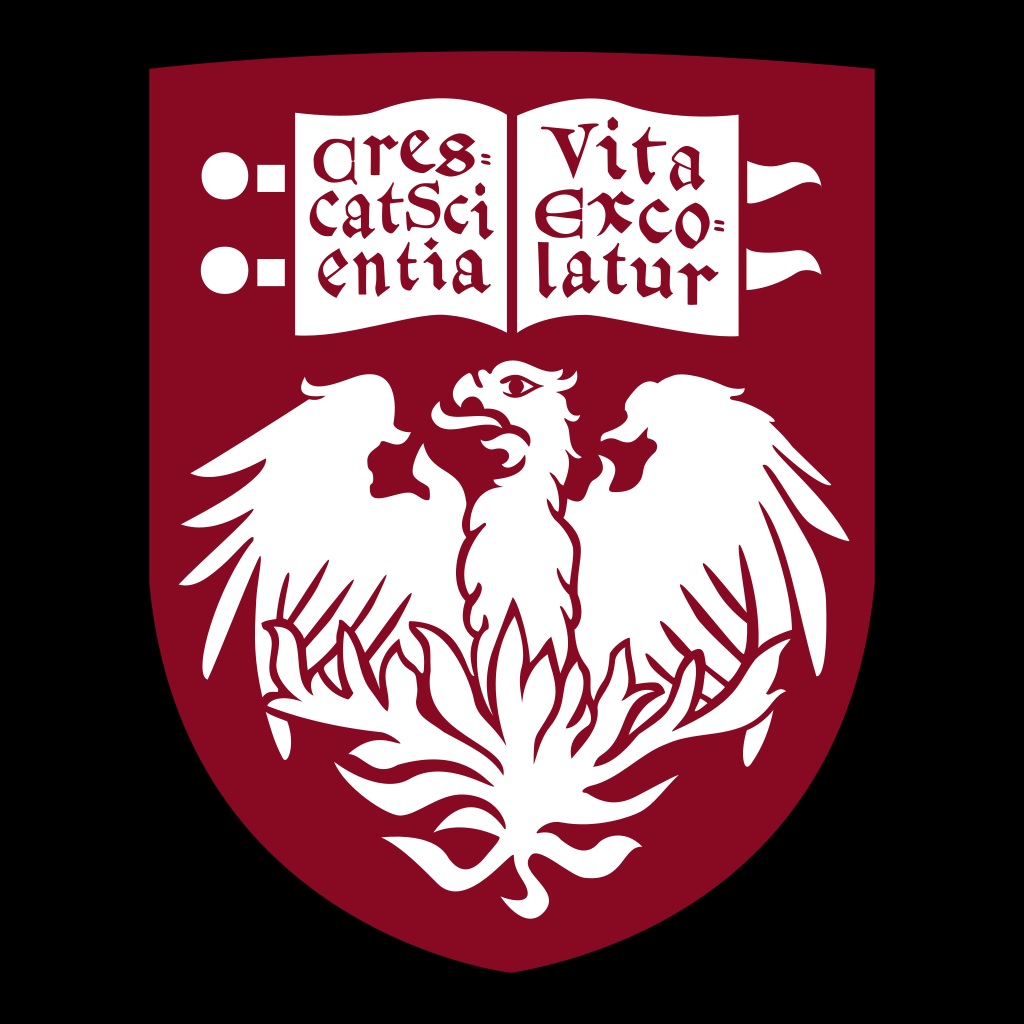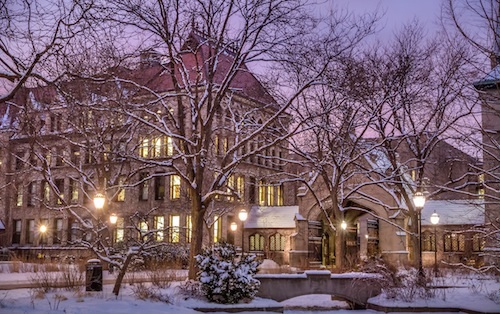From The University of Chicago
5.22.24
Louise Lerner
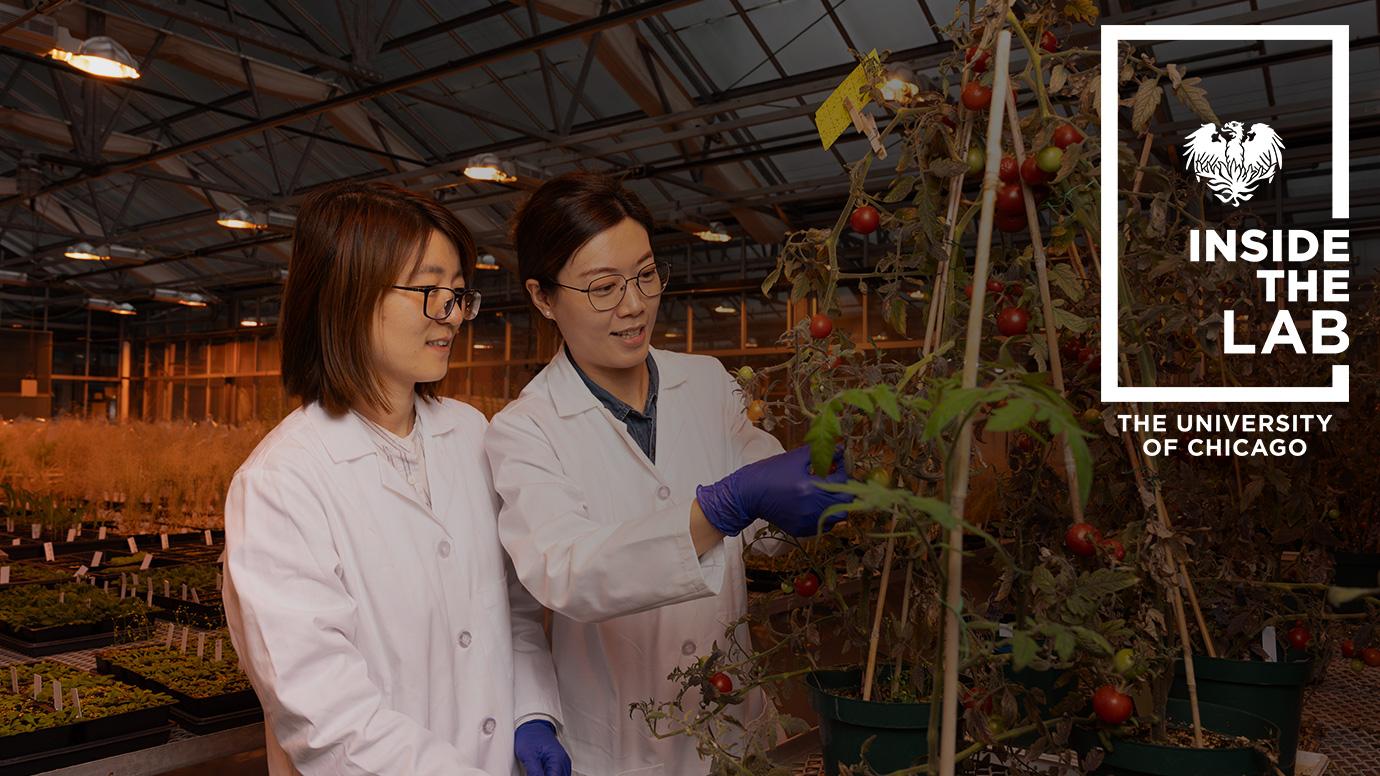
Travel inside Prof. Chuan He’s lab and meet the scientists working on new ways to boost plant growth and drought resistance with a technique based on RNA.
In a sunlit greenhouse atop a biology building on the campus of the University of Chicago, members of Prof. Chuan He’s laboratory are working to modify plants so that they can yield substantially more food, even under the stress of drought.
As climate change continues, experts say extreme weather and drought will become more common—so adaptations could be critical to produce enough food to feed the world and materials to keep society running.
Years ago, He’s lab made a surprising discovery about the fundamental nature of genetics and RNA. Today, they’re using this breakthrough to develop new ways to encourage plant growth.
To take a deeper dive into the research, we spoke with Chuan He, who is the John T. Wilson Distinguished Service Professor of Chemistry, Biochemistry and Molecular Biology; and Guanqun Wang and Haoxuan Li, postdoctoral researchers working in the He laboratory.
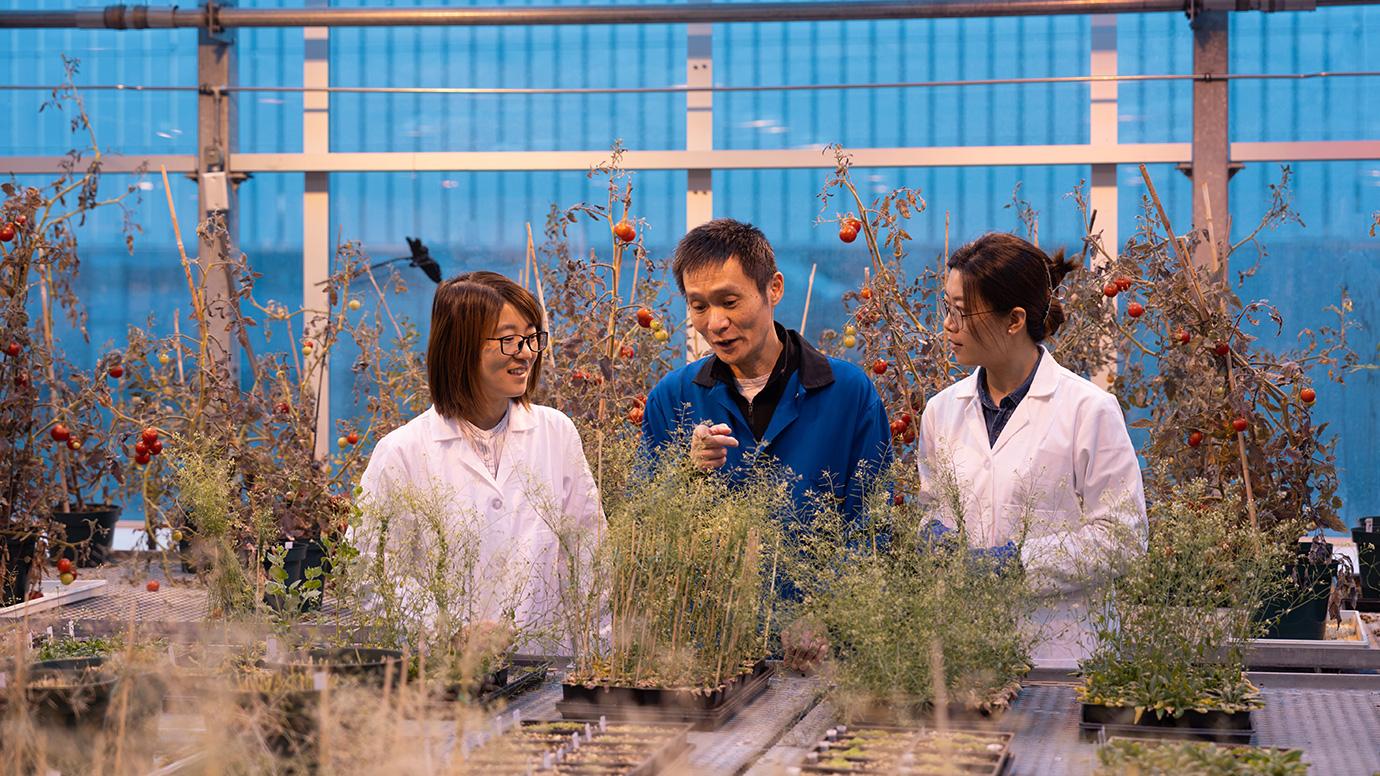
From left: Guanqun Wang, Chuan He, and Haoxuan Li. Photo by Jason Smith
What makes a plant grow bigger or smaller?
He: Plants have complicated systems to survive in different environment. When you and I see trouble, we can run away. But plants, unfortunately, have to stay where they are. So they have ways to sense the surrounding environmental conditions and adapt to them. For example, if there is not enough water, the plant may pause growth so that it needs less water.
Essentially, we found a way to modulate this regulation. We could encourage plant to grow under most conditions.
How did you first get the idea to modify plants in this way?
He: In the early 2000s, we had been wondering if there was a key piece missing from our understanding of gene expression.
We have tens of trillions of cells in our bodies. They all come from early embryos. Some become eyes, and others become kidneys, and bones etc. Yet the sequence of DNA in most cells in your body is the same. How do those cells become so different?
Well, DNA is the complete set of instructions, but those instructions are carried out by RNA. We are increasingly realizing that RNA is not just a messenger—it plays lots of regulatory roles itself. My lab discovered certain proteins that modify the RNA, which act to turn certain genes “on” and “off.” This process is reversible, so the organism can change and adapt to the environment.
In 2020, we discovered that we could use this knowledge and insert a protein into plants that affects the RNA expression in a way to make the plants grow bigger, faster, and yield more.
How much more?
He: In our tests we have been able to yield up to 50% more. For example, a rice plant will produce 30-50% more rice in the field.

The plants look similar to unmodified plants, but their roots grow longer. Photo by Jason Smith.
Which plants have you tried so far?
Li: So far, we have tried rice, potatoes and tomatoes—all of which have responded to this treatment. We’re expanding our plant list; we would also like to do soybeans and maize.
What do the modified plants look like?
Wang: These plants look like normal plants, but they have much longer roots—about double. Longer roots mean they are more robust to drought. You can also see that their leaves are greener than unmodified plants. That is because they have more chlorophyll—their rates of photosynthesis are higher.
He: They also grow faster. In many places, if you can harvest a week earlier to avoid a winter storm, that can make a huge difference.
What’s the process?
He: Essentially, we start with a piece of DNA from green algae. We transfer that gene into the DNA of whichever plant we are modifying. As the plant grows, this new gene produces a protein called FTO, which changes the way the plant interprets its genome, and causes it to grow bigger and faster.
What do you see this discovery being used for?
He: There are two major implications to me.
The first is, of course, food security—enough food to sustain the population on Earth. We all face the same problem of climate change. The temperatures are rising, but importantly, the precipitation patterns are also changing.
In the places where you grow corn, or raise cattle on grass, some of those places won’t have enough rain to sustain that anymore. That will eventually reshape our agriculture. And it calls for crops that are more resistant to drought and stress.
But also, we’re talking about other materials we need. Lots of those things come from plants. Paper comes from plants, as do biofuels. Imagine if we can increase the yield of those things.
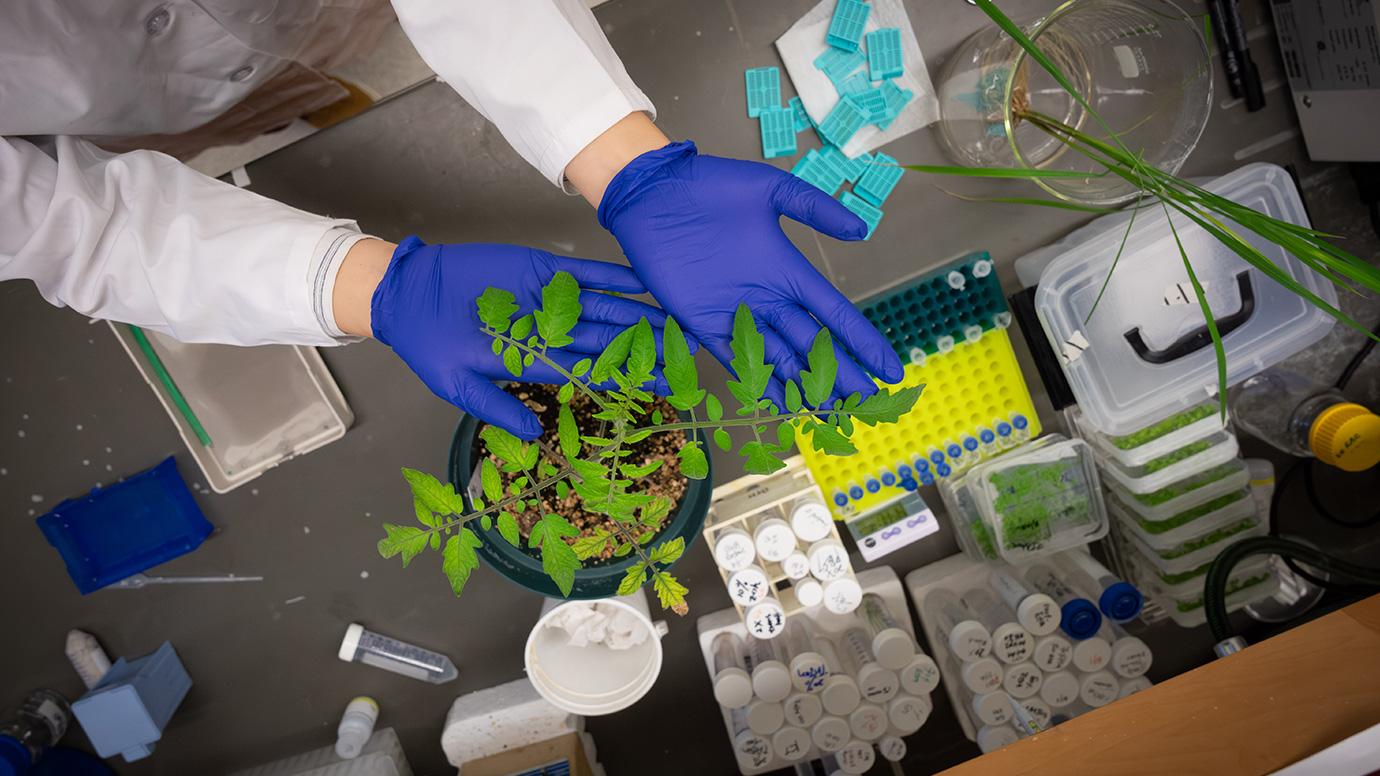
“So far, we have tried rice, potatoes and tomatoes—all of which have responded to this treatment,” said postdoctoral researcher Haoxuan Li. Photo by Jason Smith
What would you say to someone who is nervous about GMO plants?
He: Well, with our method, it’s a little different from what most people think of with genetic engineering.
We’re not really changing the genome itself. What we change is the modifications the plant makes to RNA. We add a protein which changes the way the existing genome is interpreted by the plant.
Right now, that particular protein is taken from green algae and put into plants, but we are working to find a way that avoids using a foreign protein. In that case, you would only be using the plant’s own mechanisms.
What kind of equipment do you use in your lab? What does the process look like?
Wang: In the greenhouse, we measure how fast the modified plants are growing and other things, like their photosynthetic rates. Then we will take clippings of the plants and do single-cell sequencing of the rice or roots of the plants—meaning we map out how the DNA or RNA was expressed in a particular cell—in order to try to understand exactly what happened in the plants as a result of the modification. We’ll also run experiments; maybe we reduce the amount of water or fertilizer in the environment and see how the plants respond.
What role do students play in your research?
He: They are the key drivers in the lab, not only executing experiments but also proposing new ideas. We are partners.
What are the challenges you’re working on right now?
Wang: A major goal is to understand the specific molecular mechanisms behind these changes. Right now, we know that the plants grow better, but we cannot specifically say why.
Li: Some of the challenges we face are technological. For example, we would love to be able to watch the plants’ stem cells divide, like you can do with animal studies. But plants have thick cell walls that are harder to see through, so we can’t use the same technology that is used with mammalian cells.
In general, there is much less research on plants—we know a lot less about them than we do about animals—so there is a lot of new ground to cover.
See the full article here .
Comments are invited and will be appreciated, especially if the reader finds any errors which I can correct.
five-ways-keep-your-child-safe-school-shootings
Please help promote STEM in your local schools.
The University of Chicago is an urban research university that has driven new ways of thinking since 1890. Our commitment to free and open inquiry draws inspired scholars to our global campuses, where ideas are born that challenge and change the world.
We empower individuals to challenge conventional thinking in pursuit of original ideas. Students in the College develop critical, analytic, and writing skills in our rigorous, interdisciplinary core curriculum. Through graduate programs, students test their ideas with University of Chicago scholars, and become the next generation of leaders in academia, industry, nonprofits, and government.
University of Chicago research has led to such breakthroughs as discovering the link between cancer and genetics, establishing revolutionary theories of economics, and developing tools to produce reliably excellent urban schooling. We generate new insights for the benefit of present and future generations with our national and affiliated laboratories: the DOE’s Argonne National Laboratory, the DOE’s Fermi National Accelerator Laboratory , and the Marine Biological Laboratory in Woods Hole, Massachusetts.
The University of Chicago is enriched by the city we call home. In partnership with our neighbors, we invest in Chicago’s mid-South Side across such areas as health, education, economic growth, and the arts. Together with our medical center, we are the largest private employer on the South Side.
In all we do, we are driven to dig deeper, push further, and ask bigger questions—and to leverage our knowledge to enrich all human life. Our diverse and creative students and alumni drive innovation, lead international conversations, and make masterpieces. Alumni and faculty, lecturers and postdocs have gone on to become Nobel laureates, CEOs, university presidents, attorneys general, literary giants, and astronauts. The University of Chicago was founded in 1890. Its main campus is located in Chicago’s Hyde Park neighborhood. The University of Chicago is ranked among the top universities in the world by major education publications, and it is among the most selective in the United States.
The university is composed of one undergraduate college and five graduate research divisions, which contain all of the university’s graduate programs and interdisciplinary committees. Chicago has eight professional schools: the Law School, the Booth School of Business, the Pritzker School of Medicine, the School of Social Service Administration, the Harris School of Public Policy, the Divinity School, the Graham School of Continuing Liberal and Professional Studies, and the Pritzker School of Molecular Engineering. The university has additional campuses and centers in London, Paris, Beijing, Delhi, and Hong Kong, as well as in downtown Chicago.
University of Chicago scholars have played a major role in the development of many academic disciplines, including economics, law, literary criticism, mathematics, religion, sociology, and the behavioralism school of political science, establishing the Chicago schools in various fields. Chicago’s Metallurgical Laboratory produced the world’s first man-made, self-sustaining nuclear reaction in Chicago Pile-1 beneath the viewing stands of the university’s Stagg Field. Advances in chemistry led to the “radiocarbon revolution” in the carbon-14 dating of ancient life and objects. The university is also home to the University of Chicago Press, the largest university press in the United States. The Barack Obama Presidential Center is expected to be housed at the university and will include both the Obama presidential library and offices of the Obama Foundation.
The University of Chicago’s students, faculty, and staff have included many Nobel laureates. The university’s faculty members and alumni also include Fields Medalists, Turing Award winners, MacArthur Fellows, Marshall Scholars, Pulitzer Prize winners, National Humanities Medalists, living billionaire graduates, and a number of Olympic medal winners.
Research
The University of Chicago is classified among “R1: Doctoral Universities – Very high research activity” and is a founding member of the Association of American Universities and was a member of the Committee on Institutional Cooperation from 1946 through June 29, 2016, when the group’s name was changed to the Big Ten Academic Alliance. The University of Chicago is not a member of the rebranded consortium, but will continue to be a collaborator.
The university operates more than 140 research centers and institutes on campus. Among these are the Oriental Institute—a museum and research center for Near Eastern studies owned and operated by the university—and a number of National Resource Centers, including the Center for Middle Eastern Studies. Chicago also operates or is affiliated with several research institutions apart from the university proper. The university manages the DOE’s Argonne National Laboratory, part of the United States Department of Energy’s national laboratory system, and co-manages the DOE’s Fermi National Accelerator Laboratory, a nearby particle physics laboratory, as well as a stake in the the Apache Point Observatory in Sunspot, New Mexico.
______________________


______________________
Faculty and students at the adjacent Toyota Technological Institute at Chicago collaborate with the university. In 2013, the university formed an affiliation with the formerly independent Marine Biological Laboratory in Woods Hole, Mass. Although formally unrelated, the National Opinion Research Center is located on Chicago’s campus.
